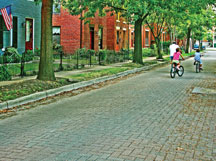
Interlocking Concrete Pavements
Interlocking concrete pavements are extensively used in low-speed urban and rural roads throughout Europe and are seeing increased use as an alternative to asphalt and cast-in-place concrete in the United States. A proposed new ASTM International standard will address the management by city and county transportation agencies of roads made from interlocking concrete pavements.
The proposed new standard, WK32564, Practice for Pavement Condition Index Surveys for Interlocking Concrete Roads and Parking Lots, is being developed by Subcommittee E17.42 on Pavement Management and Data Needs, part of ASTM International Committee E17 on Vehicle-Pavement Systems.
"Many cities have computerized pavement management systems in place built from condition surveys of road pavements," says David R. Smith, technical director, Interlocking Concrete Pavement Institute, and a member of E17 and other ASTM committees. "These are based on surveys that characterize the condition of pavements using a pavement condition index, or PCI, a number from 0 to 100 (0 meaning useless and 100 meaning new pavement) that characterizes various conditions and severities, and suggests when maintenance might be needed."
Smith notes that many of these management systems are based on D6433, Practice for Roads and Parking Lots Pavement Condition Index Surveys. The proposed new standard is similar to D6433 and will allow users to compare and model the performance of interlocking concrete pavements to asphalt and cast-in-place concrete pavements."Smith also notes, "Municipalities must have asset management systems in place to comply with accepted accounting practices that ultimately influence their ability to issue bonds for long-term financing of public capital projects such as schools, roads and bridges."
According to Smith, once approved, the proposed new standard will enable an "apples to apples" performance comparison of various pavements for municipalities and will guide city and county transportation agencies in indicating when interlocking concrete pavements need maintenance.
Interested parties are invited to join in the standards developing activities of E17.42. Smith hopes their participation will continue once the proposed new standard is approved.
"WK32564 is based on surveying the condition of over 80 interlocking concrete road pavements in a range of vehicular traffic and geographic locations," says Smith. "Once it is approved, we would encourage users to try the survey methods as well as those used to create a condition index. We would like such information to help validate the method. I would like to receive comments on the use of the standard and survey data if users are willing to share them."
CONTACT Technical Information: David R. Smith, Interlocking Concrete Pavement Institute • Herndon, Va. • Phone: 703-657-6900, ext. 201 • E-mail: dsmith@icpi.org O ASTM Staff: Daniel Smith • Phone: 610-832-9727 • E-mail: dsmith@astm.org O Upcoming Meeting: June 5-6 • State College, Pa.
 SN Home
SN Home Archive
Archive Advertisers
Advertisers Masthead
Masthead RateCard
RateCard Subscribe
Subscribe Email Editor
Email Editor